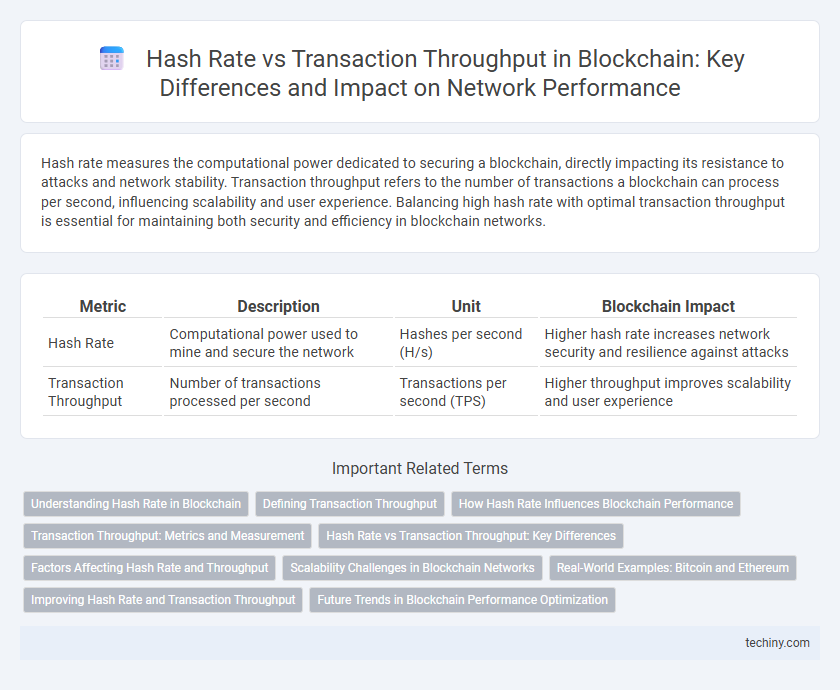Hash rate measures the computational power dedicated to securing a blockchain, directly impacting its resistance to attacks and network stability. Transaction throughput refers to the number of transactions a blockchain can process per second, influencing scalability and user experience. Balancing high hash rate with optimal transaction throughput is essential for maintaining both security and efficiency in blockchain networks.
Table of Comparison
| Metric | Description | Unit | Blockchain Impact |
|---|---|---|---|
| Hash Rate | Computational power used to mine and secure the network | Hashes per second (H/s) | Higher hash rate increases network security and resilience against attacks |
| Transaction Throughput | Number of transactions processed per second | Transactions per second (TPS) | Higher throughput improves scalability and user experience |
Understanding Hash Rate in Blockchain
Hash rate measures the computational power used by miners to validate transactions and secure a blockchain network, directly impacting network security and difficulty adjustment. Higher hash rates typically indicate stronger resistance to attacks like 51% attacks, but do not directly increase transaction throughput, which is determined by the blockchain protocol's design and block size. Optimizing hash rate ensures faster block validation and consensus confidence, while transaction throughput depends on scalability solutions such as sharding or layer-2 technologies.
Defining Transaction Throughput
Transaction throughput measures the number of transactions a blockchain network can process per second (TPS), indicating its capacity and efficiency. Hash rate reflects the computational power used to secure the network, primarily influencing security rather than transaction speed. A higher transaction throughput enhances scalability but requires optimized consensus mechanisms beyond raw hash power.
How Hash Rate Influences Blockchain Performance
Hash rate directly impacts blockchain performance by determining the network's security and the speed at which new blocks are mined. A higher hash rate increases computational power, reducing the time between block validations and enabling greater transaction throughput. Conversely, lower hash rates can slow transaction processing and make the blockchain more vulnerable to attacks.
Transaction Throughput: Metrics and Measurement
Transaction throughput in blockchain measures the number of transactions a network can process per second (TPS), reflecting the system's efficiency and scalability. Metrics such as TPS are critical for evaluating blockchain performance, with higher throughput indicating faster transaction validation and confirmation times. Measurement of throughput involves analyzing block size, block time, and network latency to optimize overall transaction processing capacity.
Hash Rate vs Transaction Throughput: Key Differences
Hash rate measures the computational power used to secure a blockchain network, reflecting its mining capacity and overall security level. Transaction throughput, expressed in transactions per second (TPS), indicates how many transactions the network can process within a given time frame. Higher hash rate enhances network security by making attacks more difficult, while increased transaction throughput improves scalability and user experience by enabling faster transaction processing.
Factors Affecting Hash Rate and Throughput
Hash rate and transaction throughput in blockchain are primarily influenced by network difficulty, mining hardware efficiency, and consensus algorithms. Higher hash rates, driven by advanced ASIC miners, improve security but do not directly increase transaction throughput, which depends on block size and block interval. Network congestion and protocol design also play critical roles in balancing hash rate with effective transaction processing capacity.
Scalability Challenges in Blockchain Networks
Hash rate directly influences the security of blockchain networks, while transaction throughput determines their processing capacity. Scalability challenges arise as increasing hash rates for consensus often limit throughput due to resource-intensive mining processes and block size constraints. Optimizing both hash rate and transaction throughput is critical for achieving scalable and secure blockchain performance.
Real-World Examples: Bitcoin and Ethereum
Bitcoin's hash rate, exceeding 300 exahashes per second (EH/s), emphasizes its focus on security through proof-of-work, but limits transaction throughput to approximately 7 transactions per second (TPS). Ethereum, transitioning to proof-of-stake with network upgrades like Ethereum 2.0, balances a lower hash rate with higher throughput, processing around 30 TPS and scaling further via layer-2 solutions. These differences highlight trade-offs between decentralization, security, and transaction speed in real-world blockchain applications.
Improving Hash Rate and Transaction Throughput
Improving hash rate enhances blockchain security by increasing computational power dedicated to validating transactions, making attacks more difficult and network integrity stronger. Optimizing transaction throughput involves scaling solutions such as sharding, off-chain processing, and consensus algorithm improvements to process more transactions per second without compromising decentralization or security. Balancing higher hash rates with efficient transaction throughput ensures a blockchain network can maintain speed, security, and scalability effectively.
Future Trends in Blockchain Performance Optimization
Emerging blockchain architectures aim to balance hash rate improvements with transaction throughput to achieve scalable performance without compromising security. Innovations such as sharding, layer 2 solutions, and proof-of-stake consensus mechanisms are expected to optimize computational efficiency and increase throughput exponentially. Future trends prioritize adaptive algorithms that dynamically allocate resources, enabling networks to handle higher transaction volumes while maintaining robust hash rate integrity.
hash rate vs transaction throughput Infographic

 techiny.com
techiny.com